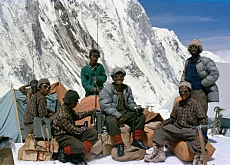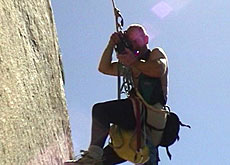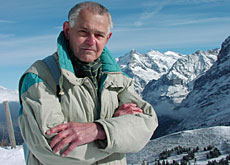Photographic mountain heritage goes online

As part of its centenary celebrations, the Swiss Alpine Museum in Bern is making its impressive photography collection available online.
The archive includes around 160,000 photographs portraying climbing feats, mountain peoples and the dramatic changes to the world’s great ranges over the past 150 years.
The collection includes rare examples dating back to the beginnings of mountain photography – around 1860 – as well as contemporary pictures.
“It’s incredible when you think of the efforts people made in the early days to take a photograph,” says museum director, Urs Kneubühl.
“Some photographers organised mountaineering expeditions just to take two or three pictures,” he told swissinfo.
At the moment the digital archive only includes about 400 images from the estate of the legendary Swiss alpinist and photographer, Dölf Reist, who died in 2000.
It is, however, a first step to making what is considered a collection of international importance available to the public worldwide.
Everest
Of great interest among the pictures already online is Reist’s documentation of the first Swiss ascents of Mount Everest in 1956 – the second and third ever.
Besides the first convincing picture of a man standing on top of the world’s highest mountain, the collection includes loving snapshots of Nepalese villagers met along the way.
Reist captured a people with assured but innocent looks, already used to the presence of climbing entourages but unprepared for the foreign onslaught to come.
The images also chronicle the pioneering hot-air balloon flight over the Alps the photographer made with climber Jürg Marmet a year after the two had conquered Everest.
Tourism boom
While mountaineering is the focus of the pictures from the 1960s, the Bernese photographer also trained his lens on the beginnings of mass tourism in the Swiss Alps.
The boom was in many ways far more noteworthy than the exploits of the climbers, who had already claimed the most difficult alpine routes.
In one picture Reist concentrates not on the risk-taking alpinists crawling up the infamous north face of the Eiger, but on the reaction of a tour group watching them.
What first seems to be an abstract work of art in another turns out to be a bird’s eye view of a narrow road snaking its way up a steep mountainside. The image pays homage to Swiss efforts to conquer the Alps with asphalt instead of ice axes, which was seen in the post-war period as an equally worthy achievement.
Globetrotter
There are also many examples of Reist’s climbing expeditions to the four corners of the globe and his images reveal a photographer who respected the indigenous peoples he met as much as the mountains he climbed.
Curator Susanne Grieder says the museum will continue to put more pictures from its huge collection online. They will include images from a variety of artists spanning the entire history of alpine photography.
A select number are currently on display as part of a temporary exhibition at the museum, including 19th century shots of lady climbers in ankle-length dresses resting on top of glaciers and peasants posing with their mules.
Robert Bösch and Thomas Ulrich are the most noteworthy contemporary photographers lending their names to the museum’s collection.
Bösch’s pictures adorn many calendars and books while Ulrich has made a name for himself documenting his extreme adventures.
In 2003 he and a Norwegian alpinist were the first to cross the Patagonian icefields unassisted. A photo essay appeared in National Geographic.
The online archive is currently available via the museum’s German website (see related sites).
swissinfo, Dale Bechtel
The Swiss Alpine Museum has more than 160,000 photographs in its collection.
It has begun digitalising the photographs in order to make them available online.
Some of the pictures are part of the temporary exhibition now showing at the museum, “An Instant Caught for Eternity”, documenting mountain photography from 1860 to the present day.

In compliance with the JTI standards
More: SWI swissinfo.ch certified by the Journalism Trust Initiative



You can find an overview of ongoing debates with our journalists here. Please join us!
If you want to start a conversation about a topic raised in this article or want to report factual errors, email us at english@swissinfo.ch.